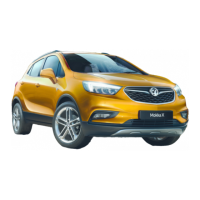
Do you have a question about the Vauxhall Mokka X and is the answer not in the manual?
| Brand | Vauxhall |
|---|---|
| Model | Mokka X |
| Category | Automobile |
| Language | English |
Section to record vehicle data like fuel, engine oil, tyre pressure, and weights for easy reference.
Explains symbols for danger, warnings, and cautions regarding vehicle operation and safety.
Instructions for unlocking the vehicle using the key or remote control, and opening doors/tailgate.
Instructions for adjusting seat position, including longitudinal, backrest, and height.
Guidance on adjusting and removing head restraints for safety and comfort.
Details on fastening, unfastening, and proper positioning of seat belts for safety.
Information on key types, lock cylinders, and obtaining replacement keys.
How the central locking system unlocks/locks doors, load compartment, and fuel filler flap.
Covers anti-theft locking system and anti-theft alarm system activation.
Information on windscreen, manual windows, power windows, and heated rear window.
Details on operating power windows, safety functions, and override functions.
Covers seat position, longitudinal, backrest, height, and inclination adjustments.
Guidance on fastening, proper use, belt force limiters, and belt pretensioners.
Explanation of front, side, and curtain airbag systems and their operation.
Procedure for deactivating the front passenger airbag for child seat installation.
Recommendations and instructions for selecting and using child restraint systems.
Table detailing permissible options for fitting child restraints based on weight class and seat.
Details on storage compartments located next to the steering wheel and in the centre console.
Details on the integrated bicycle carrier system, its capacity and usage.
Information on load compartment extension and general loading information.
Designed to secure items against slippage using straps or luggage nets.
Guidelines for placing heavy objects, securing loads, and not obstructing driver view.
Instructions on how to adjust the steering wheel for optimal driver position.
Covers operation of windscreen wiper speeds, interval, and washer system.
Details on activating the rear window wiper and washer functions.
Explanation of the speedometer, odometer, fuel gauge, and various warning lights.
Indicates coolant temperature, from not yet reached to too high.
Informs about engine oil life duration and when to change oil and filter.
Explains how front and rear seat belt reminders operate and indicate status.
Explains the yellow malfunction indicator light for emission control system faults.
How TPMS checks tyre pressure, warns of low pressure, and indicates system faults.
Meaning of the red indicator for low engine oil pressure and associated risks.
Explanation of the light switch, automatic light control, and high beam operation.
How high beam assist functions, switches to low beam, and its activation/deactivation.
Explanation of AFL functions with LED headlights, light distribution, and intensity.
How to operate the front fog lights using the switch.
Details on welcome lighting, entry lighting, and illumination upon driver's door opening.
How low beam, sidelights, and tail lights illuminate the area after leaving the vehicle.
Controls for air distribution, temperature, fan speed, and demisting/defrosting.
Steps to clear windows, including fan speed, temperature, and rear heated window.
Covers cooling and air recirculation modes for optimal cabin comfort.
Explanation of automatic and manual settings for temperature, fan speed, and air distribution.
Basic settings for maximum comfort using automatic air distribution and fan speed.
An electric heater that warms up the passenger compartment quickly.
Guidance on safe vehicle control, especially regarding engine off situations and Autostop.
Explanation of positions 0, 1, 2, and 3 for ignition off, accessory, on, and engine start.
How to start and stop the engine using the Engine Start/Stop button.
Step-by-step guide for starting the engine with ignition switch or power button.
How the system saves fuel and reduces emissions by switching off the engine.
Safety warnings for parking on ignitable surfaces and applying the parking brake.
Danger of carbon monoxide in exhaust gases and how to handle exposure.
Explanation of automatic and manual cleaning processes for the diesel particle filter.
Covers automatic and manual gearshifting, transmission display, and selector lever.
How ABS prevents wheel locking and its operation during hard braking.
How TC improves stability by preventing drive wheel spin and reducing engine output.
How ESC improves stability by reducing engine output and braking wheels individually.
How to store and maintain speeds, and conditions for activation.
How the system prevents exceeding a preset maximum speed.
How the system helps avoid or reduce harm from front-end crashes.
How parking assist makes parking easier with distance measurement and acoustic signals.
Assists driver when reversing by displaying area behind vehicle.
System detects and displays designated traffic signs via front camera.
Observes lane markings and warns driver of unintended lane changes.
Details on fuel types, octane ratings, and recommendations for petrol and diesel engines.
Safety instructions for refuelling petrol, diesel, and LPG, including danger warnings.
Information on permissible trailer loads, gradients, and altitude effects.
Recommendations on genuine parts, accessories, and potential warranty invalidation from modifications.
Steps for storing the vehicle for months, including cleaning, fluid checks, and battery disconnection.
General guidance on performing checks and work, with safety warnings for engine compartment.
How to manually check engine oil level, recommended fluids, and consumption.
Information on coolant's freeze protection and the use of approved antifreeze.
Information on brake lining wear and the need for replacement.
Warning about brake fluid being poisonous and corrosive, and need for replacement.
Guidance on battery maintenance, short-distance driving impact, and avoiding unnecessary consumers.
Warning about charging voltage limits and jump starting procedures.
Step-by-step instructions for replacing windscreen and rear window wiper blades.
General advice on bulb replacement, safety warnings for halogen bulbs, and LED lighting.
How to identify blown fuses, when to replace them, and safety precautions.
Covers tyre condition, winter tyres, and tyre designations.
How to check cold tyre pressure, before journeys, and before inflating.
How TPMS checks tyre pressure, warns of low pressure, and indicates system faults.
Procedure for matching tyre pressure sensors after wheel rotation or replacement.
Consequences of changing tyre size, including speedometer reprogramming.
Instructions and warnings for using tyre chains, permitted sizes, and not on temporary spare.
How to repair minor tyre tread damage and limitations of the kit.
Preparations and safety information for changing a wheel.
Detailed steps for using the compressor and sealant bottle to inflate tyres.
Location and classification of spare wheels, including speed limits for temporary spares.
Warnings and guidelines for using a temporary spare wheel, including speed and curve limits.
Detailed instructions and safety warnings for jump starting using another vehicle's battery.
Warnings about towing AWD vehicles and driving jerkily; exhaust gas prevention.
Instructions for towing with manual and automatic transmissions, and using towing eyes.
Advice on washing, waxing, and cleaning exterior parts like lights and plastic body parts.
Safety warnings regarding liquid gas being heavier than air and potential leaks.
Guidelines for cleaning interior and upholstery, including fabric and leather care.
Importance of maintenance for economical and safe operation and value retention.
Importance of maintenance intervals and availability of service schedules at the workshop.
Service interval determined by parameters including remaining engine oil life.
Use only products meeting recommended specifications for optimal performance.
Importance of oil quality and viscosity for engine cleanliness, wear protection, and aging control.
Use only organic acid type-long life coolant; factory fill provides frost protection.
Brake fluid absorbs moisture over time, reducing braking effectiveness; requires replacement.
Details on vehicle identification number location and the identification plate.
Recommended engine oil quality and viscosity grades based on ambient temperature.
Table showing engine identifier code, sales designation, piston displacement, power, torque, and fuel type.
Maximum speed figures for different engines and transmissions, including AWD system notes.
Kerb weight figures for different engines and transmissions, without optional equipment.
Table of vehicle dimensions including length, width, height, and wheelbase.
Table showing engine oil and fuel tank capacities for various engines.
Table of recommended tyre pressures for comfort, ECO, and full load conditions.
Vehicle systems comply with EU directives regarding radio wave transmission.
Information on data storage modules, vehicle conditions, events, errors, and privacy.
RFID technology for tyre pressure monitoring, ignition security, and remote controls.











